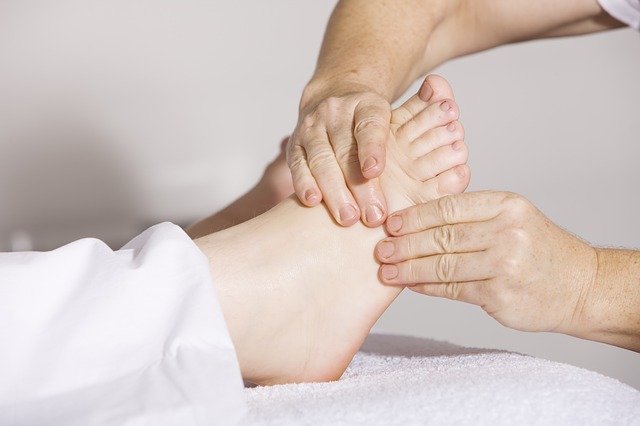Maybe you went out last night and had a great time in some gorgeous heels. Maybe you’ve been stepping up your workouts lately. Whether it’s caused by work or play, you now have that familiar but brutal soreness along the bottom of your foot.
That’s called plantar fasciitis. It sounds like a complex medical term, but it just means that the ligament along the bottom of your foot is inflamed and sore.
The good news is that plantar fasciitis tends to heal on its own, so no need for a trip to the doctor. The bad news is that the top way to treat it is to rest. As hard as you might try, most of us aren’t able to take much time off our feet.
You’ll be happy to learn that there are other ways to find relief from plantar fasciitis pain as well. Try these tips.
Ways to Get Relief from Plantar Fasciitis Pain (Besides Slowing Down)
If you don’t have the luxury of taking time off, these tips can help you find relief.
Invest in Custom Insoles
There are many reasons you may develop plantar fasciitis, and it’s often the result of several combining factors. One of the most common causes, though, is either flat feet or arches that are too high.
If your feet have unusual arches, chances are that shoes off the rack won’t have the support you need. In this case, insoles designed for your arches can make a world of difference.
You could do some trial and error with insoles from the drug store. For a more direct approach, though, go to a speciality shoe store or an orthopedist for customized insoles.
Feel the Stretch
The best treatments are those that will help you heal from plantar fasciitis while making the condition less likely in the future. That’s what the right stretches and exercises for plantar fasciitis can do for you.
The key is finding the right stretches. One option is a towel stretch. Loop a towel around the ball of your foot and pull on each end, stretching your foot.
Another great stretch is to curl your toes and then relax them, repeating this over and over. Holding your foot up and making circles with your ankles can offer a helpful stretch as well.
Build Your Shoe Wardrobe
As much as you might love your stilettoes, some shoes lend themselves to plantar fasciitis. We’re not suggesting that you toss out your favorite heels, but you should have some comfy options on hand for those painful days.
Read advice here about the best types of shoes to wear if you’re struggling with plantar fasciitis.
Take Over the Counter Anti-Inflammatory Medicine
On those days when you wake up with sore feet and you have an active day ahead, it’s time to take advantage of modern medicine.
Look for an over-the-counter pain reliever that has an anti-inflammatory component. Most of the popular pain relievers do this, like ibuprofen and Tylenol.
Treat Yourself to Massages
We know you don’t need another reason to go get a foot massage, but we’ll give you one anyway.
A foot massage doesn’t just feel great on a sore foot. It also stimulates your blood flow, which helps your body heal faster.
If your budget won’t allow for a professional massage every time you have plantar fasciitis, don’t fret. Try the old trick of rolling a tennis ball under your foot or buy a foot massage online. If you have a significant other, we’re willing to bet that you can goad them into giving you a foot massage too.
Ice it Down
We know you’re a busy gal and finding time off your feet isn’t your forte. When you do get a chance to relax, though, try icing your feet. This will help to reduce the inflammation.
To help the ice conform to your foot, try freezing a half-full bottle of water. You could also soak your feet in a tub of icy water for a similar effect. In either case, limit your icing time to 20 minutes at a time with at least 20 minutes between each icing session.
Modify Your Workout
For some people, the most frustrating part of plantar fasciitis is that it can keep them from working out. Before you give up on your pre-holiday push to get in shape, you do have other options.
Running and walking tend to be the worst culprits for plantar fasciitis. Instead, try low-impact options like swimming or cycling. If you incorporate these into your workout more often, it will help you cut down on future problems with sore feet as well.
Try Physical Therapy
Remember when we mentioned that several factors can contribute to plantar fasciitis? If you’re having the pain often, you might have some irregularities in your gait or the way you walk.
When you walk or run, your feet might land at a slight angle. You’d never know it unless you see a specialist, but that slight angle can add up to not-so-slight foot pain.
If that’s the case, a physical therapist may be able to help you adjust your gait. Developing a straighter, healthier walk can do wonders for your long-term foot health.
Ask a Doctor About Night Splints
Let’s say you’ve tried the options above and you’re still dealing with plantar fasciitis on a frequent basis. It might be time to look at the way you sleep.
Most of us sleep with our feet pointed to some degree. This shortens the ligament on the bottom of your foot so that when you stretch it as you walk, the ligament can’t handle that level of strain.
If necessary, your doctor may recommend foot splints. The splints hold your feet at a 90-degree angle as you sleep. This helps your ligaments remain at that length so walking doesn’t become such a strain.
Tackling Your Foot Problems
Plantar fasciitis is a common issue that most of us will deal with at least a few times in our lives. If it’s happening often and you’re struggling to find relief from plantar fasciitis pain, the tips above may be able to help.
As you can tell, you don’t have to compromise your style to live a life with less foot pain. For more great tips on rocking any style you choose, check out our fashion blog.











